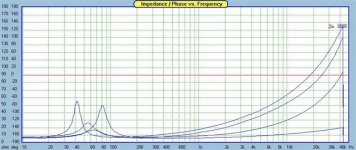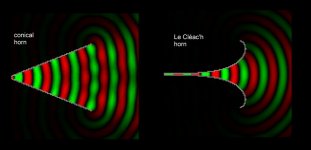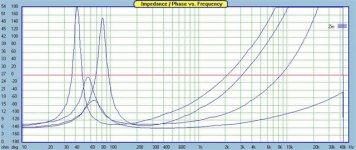markus76 said:badman, Bratislav, you guys just raise questions without accepting answers from the Doc. Why not search the available literature for yourselves? Everybody here would be thankful for a short scientific review. Or do you even have your own data to show?
Markus
Markus,
there isn't much 'in the literature' to show, as open baffles are still not a mainstream. So frankly, there isn't much but a 'hunch' on my part that what I hear when I compare good boxless speaker to a good boxed one has to do with the box itself.
Maybe I'm wrong, maybe I'm not. But there are enough smart people out there (starting with Peter Walker more than half a century ago, and continuing with Linkwitz, Kreskovsky, Salmi et al.) that are trying to dispense with boxes one way or another to keep my belief alive.
And I'm not against the good Doc, far from it. I'm in fact very grateful to Earl that he decided to generously give away lots of his findings and amassed knowledge in this forum. The only thing that stopped me from having a set of Nathans is insane price of drivers in Australia. I may still do it, if someone near me builds a pair and lets me have a listen.
Bratislav
"there isn't much 'in the literature' to show, as open baffles are still not a mainstream. So frankly, there isn't much but a 'hunch' on my part that what I hear when I compare good boxless speaker to a good boxed one has to do with the box itself."
Seems obvious to me that the biggest audible difference is the much greater proportion of reflected sound from an open baffle.
Unless you mean an OB surrounded by a wall to isolate the back radiation compared to the same driver in a box.
Seems obvious to me that the biggest audible difference is the much greater proportion of reflected sound from an open baffle.
Unless you mean an OB surrounded by a wall to isolate the back radiation compared to the same driver in a box.
"Seems obvious to me that the biggest audible difference is the much greater proportion of reflected sound from an open baffle."
I've compared them in a fairly large room (couldn't really do it outdoors) and although I agree there is going to be spectral difference becuse of radically different radiation pattern, it is possible to 'mentally supress' it with such a large delay (front wall more than 2.5m away)
But you're right, there could well be more than one difference at play. I openly admit I have no means of making that distinction.
I've compared them in a fairly large room (couldn't really do it outdoors) and although I agree there is going to be spectral difference becuse of radically different radiation pattern, it is possible to 'mentally supress' it with such a large delay (front wall more than 2.5m away)
But you're right, there could well be more than one difference at play. I openly admit I have no means of making that distinction.
noah katz said:
Seems obvious to me that the biggest audible difference is the much greater proportion of reflected sound from an open baffle.
It has been shown time and again that in relation to a fixed amount of direct radiation the dipole has a smaller proportion of reflected sound than an monopole. Yet people find the contrary "obvious", just because they can look at the cone from both sides.
We certainly can argue which of the different radiation patterns is more helpful in our personal listening situation. But "Seems obvious" is a very bad guide in a world where eyesight does not count.
I expected that, and WRT stage size and spaciousness you certainly are right.noah katz said:I was remiss in specifying that I was referring to reflected sound from surfaces behind the plane of the speaker, which gives a pronounced increase in apparent soundstage size and spaciousness.
What I really wanted to adress was the ease with which most of us throw our weak or diffuse personal believes as "truth" and "facts" into the discussion.
I apologize for taking you as the lamp post to tie my argument to.
I am quite interested whether it is visible in the data or not, at what frequency(s), and what size was the voice coil and spider diameters.gedlee said:
...
There is a small glitch in the systems that I produce that I took about a year to track down. I thought that it was one of those aspects that you mentioned - reflection trough the cone, box vibration, etc. It wasn't. It was simply the spider resonating. But no one making speakers seems to care because every driver that I have tested has this same problem. And its correctable! They just aren't interested.
...
Here are two 4" and two 6"driver impedances. Other than inductance and F0 etc. What is special?tiki said:Hello,
compare the 4" to 6" wavecor drivers, you will find interesting similarities in amplitude and impedance responses.
It is not only a matter of size unfortunately.
Attachments
And zoomed in. Are you referring to that little wriggles in the 1K~2K Hz range¡Hsoongsc said:
Here are two 4" and two 6"driver impedances. Other than inductance and F0 etc. What is special?
soongsc said:
I am quite interested whether it is visible in the data or not, at what frequency(s), and what size was the voice coil and spider diameters.
It can be seen as a dip in the response of the Summa and the Abbey in the 600 - 800 Hz range which are similar drivers in the TBX series. But could we try and keep the discussion to the topic. Its getting far away from waveguides.
Thanks.
I'm getting another smaller wave guide in for testing tomorrow. I've been playing around with some different throat area ideas just getting some listening impressions before I start another round of measurement. This time the wave guide will be axisymmetric. One driver that I've been running on seems to have changed sonically after broken in. I think it'll take some time till the next one is broken in.
I'm getting another smaller wave guide in for testing tomorrow. I've been playing around with some different throat area ideas just getting some listening impressions before I start another round of measurement. This time the wave guide will be axisymmetric. One driver that I've been running on seems to have changed sonically after broken in. I think it'll take some time till the next one is broken in.
Re: Own tries
Hello Tiki,
Here is a compared wavefronts simulation between conical and Le Cléac'h horn of the same size at 1kHz.
Best regards from Paris, France
Jean-Michel Le Cléac'h
Hello Tiki,
Here is a compared wavefronts simulation between conical and Le Cléac'h horn of the same size at 1kHz.
Best regards from Paris, France
Jean-Michel Le Cléac'h
tiki said:Hello,
thank you all for the interesting stuff, written here.
After lots of drafts this seems to be an satisfactory approach to a "waveguided" line.
The very rough measurement (the speaker driver was not equalised) shows the function in principle. Although the response is not smooth, the directivity is present down to below 1kHz. The WG is about 350mm wide and 140mm deep.
The strong narrowing above 9kHz is a matter of the too large throat, presently beeing 32mm wide, which will be narrowed to approximately 15mm later.
Does this small simulation, trying to express the wavguide, show the stated HOMs?
I want to use a "WG-formula" for round waveguides, giving the walls shape for this line type. As I read here(?), this may be not the right way.
Hints for improvements would be helpful.
Thank you in advance!
Regards, Timo
Attachments
I think different sections with different expanding curves will provide optimum performance, if care is taken blending the lip with the OS wave guide, I believe improvements will be measureable. Should be doing some listening for next week with the new wave guide at hand.
forgot the file.soongsc said:
And zoomed in. Are you referring to that little wriggles in the 1K~2K Hz range¡H
Attachments
Hello,
soongsc, yes, these little artifacts, while they are much more significant in most (serious) measurements. The bigger the driver, the lower the frequency of the artifacts. Same spiders (and surrounds) generate very similar artifacts in different drivers.
Excuse me, Earl.
Jean-Michel,
merci beaucoup. Hmm, that looks good, indeed. I have to read a bit about these horns, because I want to realise approximately constant directivity fom 1kHz up at least. Le Cléac'h horns aren't CD, are they?
I was told to find a function for which the distribution of the speed of sound across the mouth is similar to a Gauss function, using a 2dim FFT. But my math abilities are awful. I'm not able to synthesise that.
Is the very long throat really needed?
Regards
soongsc, yes, these little artifacts, while they are much more significant in most (serious) measurements. The bigger the driver, the lower the frequency of the artifacts. Same spiders (and surrounds) generate very similar artifacts in different drivers.
Excuse me, Earl.
Jean-Michel,
merci beaucoup. Hmm, that looks good, indeed. I have to read a bit about these horns, because I want to realise approximately constant directivity fom 1kHz up at least. Le Cléac'h horns aren't CD, are they?
I was told to find a function for which the distribution of the speed of sound across the mouth is similar to a Gauss function, using a 2dim FFT. But my math abilities are awful. I'm not able to synthesise that.
Is the very long throat really needed?
Regards
Starting the break-in process and listening to various music, this one seems to generate better image depth that the first big one. There does seem to exist some resonances at certain frequencies, but I'll wait for the drivers to break in a bit till I do some measurements.
This wave guide is 60deg, slight compression from the diaphragm to the throat. Note that I used a concaved diaphragm driver. The concept is to have a spherical wave front before and after the thoat which was illustrated in a picture I had posted a while back.
tiki,
I think that little wriggle in the impedance curve reduces if the cone weight reduces. Also, if the spider is a progressive spider, it should also be reduced.
This wave guide is 60deg, slight compression from the diaphragm to the throat. Note that I used a concaved diaphragm driver. The concept is to have a spherical wave front before and after the thoat which was illustrated in a picture I had posted a while back.
tiki,
I think that little wriggle in the impedance curve reduces if the cone weight reduces. Also, if the spider is a progressive spider, it should also be reduced.
- Home
- Loudspeakers
- Multi-Way
- Geddes on Waveguides


